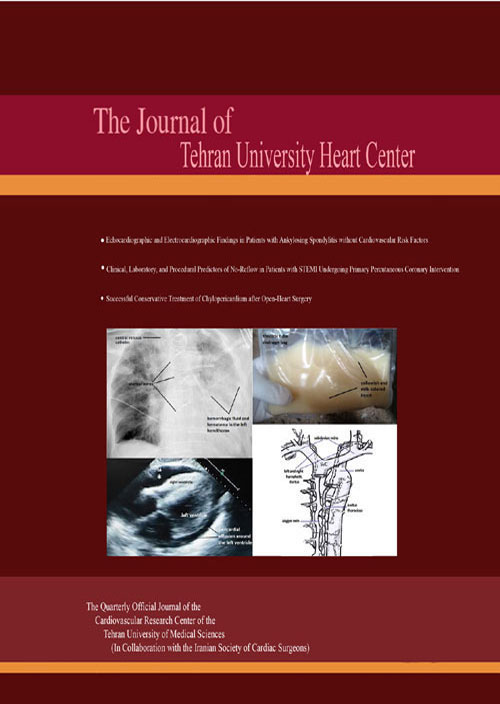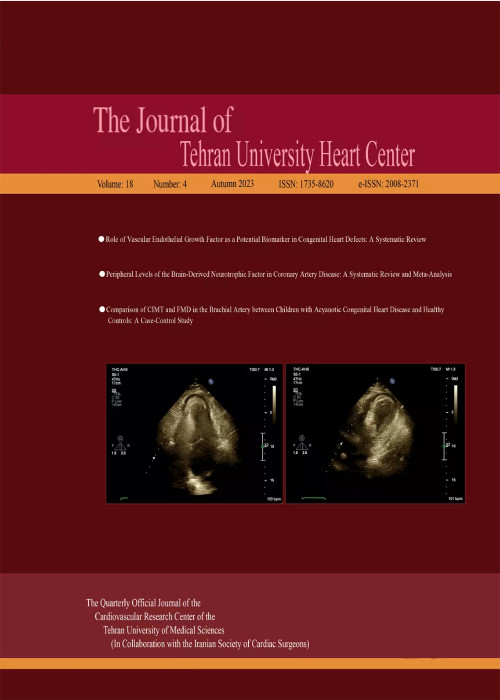فهرست مطالب

The Journal of Tehran University Heart Center
Volume:16 Issue: 2, Apr 2021
- تاریخ انتشار: 1400/07/27
- تعداد عناوین: 8
-
-
Pages 51-57Background
Calculating the burden of diseases is essential for their monitoring. The burden of cardiovascular diseases in Kurdistan Province has not been reported. This study aimed at calculating the burden of cardiovascular diseases in the Kurdistan Province from 2011 through 2017.
MethodsIn this cross-sectional study, incidence data were extracted from registration systems. The methods of the World Health Organization (WHO) were employed to calculate disability-adjusted life years (DALYs) of cardiovascular diseases in the Kurdistan Province. DALYs were calculated by summing the years of life lost (YLLs) and the years of life lived with disability (YLDs) for sex, age group, and year.
ResultsThe burden of cardiovascular diseases increased from 18569.1 DALYs in 2011 to 34929.8 DALYs in 2017. The highest increase and the largest decrease in DALY according to the all age-standardized DALYs index were related to acute myocardial infarction and heart failure in women, respectively. The highest DALYs in both sexes were in the age group of over 80 years.
ConclusionThe burden of cardiovascular diseases is increasing in the Iranian province of Kurdistan. It is, therefore, essential to implement appropriate and adequate interventions such as lifestyle modification, extensive screening, public education promotion, and operational plan development. We hope our results will aid decision-makers in performing urgent interventions.
Keywords: Cardiovascular diseases, Incidence, Iran -
Pages 58-67Background
The frequency of left ventricular diastolic dysfunction (DD) is overestimated by earlier recommendations. We compared the 2009 and 2016 guidelines regarding the detection of DD and explored the potential of adding left atrial (LA) strain to the current guideline.
MethodsConsecutive patients with heart failure were enrolled. All the patients were examined using 2-dimensional speckle-tracking echocardiography (2D-STE) and tissue Doppler imaging. DD was evaluated in terms of E/eʹ, eʹ velocity, E, A, tricuspid regurgitation velocity, LA volume, and LA strain.
ResultsThis study evaluated 147 patients (101 males, 68.7%) at a mean age of 54.73±14.42 years. LA strain decreased with increasing grades of DD in both guidelines. The rate of reclassification between the 2 guidelines was 41%. The detection rate of normal diastolic function increased after the implementation of the 2016 guideline. LA strain discriminated individuals with normal diastolic function from those with DD more accurately than did LA volume index (area under the curve [AUC] =0.816 vs AUC=0.759, respectively). When LA strain <23% was incorporated into the 2016 guideline, 2 out of 4 patients with indeterminate diastolic function were reclassified as normal and 2 patients as grade I DD. The rate of reclassification was 4.1% after the addition of LA strain to the current guideline (κ=0.939, P<0.001).
ConclusionThis study showed that the current guideline detected lower rates of DD than did the earlier recommendations. Furthermore, the incorporation of LA strain into the current guideline resulted in lower rates of indeterminate diastolic function.
Keywords: Heart failure, diastolic, Heart Atria, Echocardiography -
Pages 68-74Background
Coronary artery disease is the most common cause of death worldwide as well as in Iran. The present study was designed to predict short and long-term survival rates after the first episode of myocardial infarction (MI).
MethodsThe current research is a retrospective cohort study. The data were collected from the Myocardial Infarction Registry of Iran in a 12-month period leading to March 20, 2014. The variables analyzed included smoking status, past medical history of chronic heart disease, hypertension, diabetes, hyperlipidemia, signs and symptoms during an attack, post-MI complications during hospitalization, the occurrence of arrhythmias, the location of MI, and the place of residence. Survival rates and predictive factors were estimated by the Kaplan–Meier method, the log-rank test, and the Cox model.
ResultsTotally, 21 181 patients with the first MI were studied. There were 15 328 men (72.4%), and the mean age of the study population was 62.10±13.42 years. During a 1-year period following MI, 2479 patients (11.7%) died. Overall, the survival rates at 28 days, 6 months, and 1 year were estimated to be 0.95 (95% CI: 0.95 to 0.96), 0.90 (95% CI: 0.90 to 0.91), and 0.88 (95% CI: 0.88 to 0.89). After the confounding factors were controlled, history of chronic heart disease (p<0.001), hypertension (p<0.001), and diabetes (p<0.001) had a significant relationship with an increased risk of death and history of hyperlipidemia (p<0.001) and inferior wall MI (p<0.001) had a significant relationship with a decreased risk of death.
ConclusionThe results of this study provide evidence for health policy-makers and physicians on the link between MI and its predictive factors.
Keywords: Cox Regression, Myocardial infarction, Survival rate, Hypertension -
Pages 75-78
Tricuspid valve myxomas are very uncommon tumors that could be found after the occurrence of pulmonary thromboembolism, symptomatic tricuspid obstruction, and right-sided heart failure. Herein, we describe a 42-year-old woman evaluated for an abdominal mass. In preoperative consultation, a tricuspid valve mass was detected in echocardiography. She underwent the removal of a benign uterine myoma and a myxoma of the tricuspid valve. Tricuspid valve myxomas constitute a scarce diagnosis. They could be asymptomatic, occurring in unusual locations and in association with benign tumors in other organs. Our patient was asymptomatic, underscoring the significance of the early diagnosis of this type of tumor to prevent further catastrophic events.
Keywords: Tricuspid valve, Myoma, Uterine myomectomy, Echocardiography -
Pages 79-83
Recently, remdesivir was approved by the United States Food and Drug Administration for patients with Coronavirus disease 2019 (COVID-19). We herein describe 3 patients with COVID-19 who showed significant bradycardia and QTc prolongation after remdesivir administration. Bradycardia did not respond to atropine treatment in 2 of the patients, one of whom received theophylline and the other required a temporary pacemaker. Fortunately, the patients’ heart rate and rhythm returned to normal after the discontinuation of remdesivir, albeit it lengthened their hospital stays. Careful monitoring during remdesivir infusion may decrease the risk of adverse cardiovascular side effects.
Keywords: Arrhythmias, cardiac, Bradycardia, COVID-19, Remdesivir -
Pages 84-88
Thrombotic thrombocytopenic purpura (TTP) is a multisystem disorder that frequently manifests itself with renal and neurological involvements. Cardiac involvement, however, has been rarely reported. In this report, we present a rare case of acquired TTP with acute myocardial infarction (AMI) as the initial manifestation. Although AMI was successfully managed by percutaneous coronary intervention, the patient developed hemolytic anemia, fever, marked thrombocytopenia, oliguria, and renal dysfunction, requiring treatment with plasma exchange and corticosteroids. TTP, albeit extremely rare, should be considered in cases with unexpected thrombocytopenia during acute-phase treatment for AMI as it can be highly lethal if not treated immediately.
Keywords: Purpura, thrombotic thrombocytopenic, Lupus erythematosus, systemic, Myocardial infarction, ST elevationmyocardial infarction


